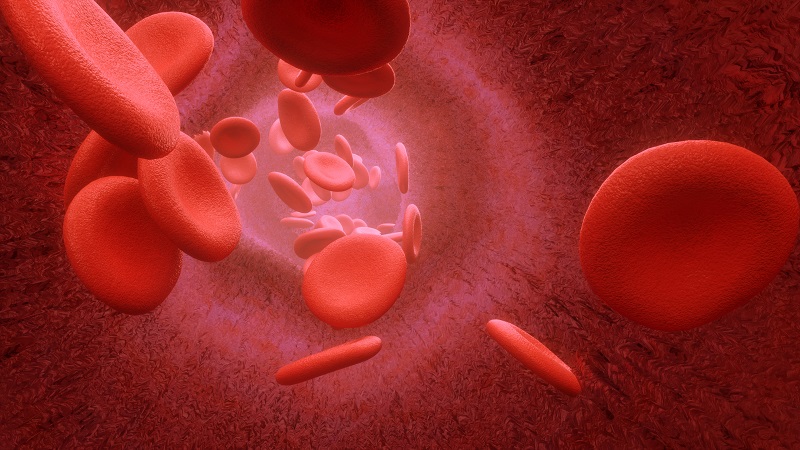
Anemia is present in adults if hemoglobin is less than 13g/dL in males and less than 12g/dL in females. The most common cause of anemia is iron deficiency. Poor diet may result in folic acid deficiency and contribute in iron deficiency, but bleeding is the most common cause of iron deficiency in adults.
Clinical Findings
Primary symptoms are easy fatigability, palpitations, breathlessness on exertion and generalised weakness. Many iron deficient patients develop pica, craving for specific foods often not rich in iron.
Classification
Anemias are classified according to red blood cell size or to their pathophysiologic basis i.e., whether related to reduced production or increased production due to increased loss of red blood cells. A severely microcytic anemia (that is, smaller red cell size) is either due to iron deficiency or thalassemia while a severely macrocytic anemia ( big cell size) is almost always Megaloblastic anemia the most common cause of which is Vitamin B12 and Folate deficiency. A bone marrow biopsy is generally needed to complete the evaluation of anemia when the blood laboratory evaluation fails to reveal the cause, when there are additional abnormalities present in the blood picture or an underlying primary or secondary bone marrow process is suspected.
General considerations
Iron deficiency Anemia
Iron deficiency is the most common cause of anemia worldwide. Causes of iron deficiency are
- Deficient Diet
- Decreased absorption - autoimmune gastritis, Celiac disease , Zinc deficiency, Helicobacter pylori gastritis.
- Increased requirements eg, pregnancy & lactation
- Blood loss (chronic)- Gastrointestinal, Menstrual, Blood donation
Anemia of Chronic Disease
Many chronic diseases are associated with mild or moderate anemia. Inflammatory bowel disease, chronic infections, malignancy, rheumatologic disorders cause reduced gut iron uptake and reduced iron transfer in the bone marrow. Anemia of organ failure can occur with kidney disease, liver failure, and endocrine gland failure. Erythropoietin is reduced and RBC mass reduces. Anemia of Older adults is present in upto 20% of individuals over age 85 years in whom a thorough evaluation for an explanation of anemia is negative.
The Thalassemias
THALASSEMIAS are hereditary disorders characterised by reduction in the synthesis of globin chains. The thalassemias are described as thalassemia trait when there is insignificant clinica impact, thalassemia intermedia when there is moderate clinical impact, and thalassemia major when the disorder is life-threatening and the patient is transfusion dependent.
Vitamin B12 & Folate Deficiency
Vitamin B12 is present in foods of animal origin, dietary vitamin B12 deficiency is seen in vegans- strict vegetarians who avoid all dairy products, meat, and fish. Pernicious anemia (autoimmune), gastrectomy, fish tapeworm infection , H.Pylori infection, Proton pump inhibitors ( medication used to reduce acidity) and surgical gut resection are some other causes of Vitamin B12 deficiency and consequent anemia. Folic acid is present in most fruits and green leafy vegetables and most common cause of folic acid deficiency is inadequate dietary intake. Celiac disease, medications such as methotrexate and phenytoin, pregnancy and chronic hemolysis anemias are other causes.
Hemolytic Anemias
The hemolytic anemias are a group of disorders in which RBC survival is reduced – episodically or continuously. There are several types of hemolytic anemias based on whether the defect is intrinsic to the RBC or due to some external factor. There are several other causes of anemia like aplastic anemia, paroxysmal nocturnal hemoglobinuria, sickle cell anemia, autoimmune hemolytic anemia and cold agglutinin disease.
Laboratory findings
Basic blood work includes a Complete blood count, Liver functions, Kidney function test, general blood picture, iron studies, vitamin B12 & Folate assays, Reticulocyte count, serum LDH, Coombs test, gastrointestinal studies like colonoscopy and endoscopy May be needed to find the cause of chronic blood loss if that is suspected, routine stool tests for parasites are usually done. Imaging studies and Bone marrow biopsy may be required in certain cases.
Treatment
Treatment of anemia depends on correction of the underlying cause. Dietary supplements for iron and vitamin B12 and folate in cases of deficiency. Treatment of H. pylori infection or parasitic infestation if needed. Celiac disease related anemia would improve on exclusion of gluten from diet. Erythropoietin injections for CKD related anemia, parenteral iron therapy if oral is not tolerated or patient has concomitant IBD thereby reducing orally administered iron. Steroid therapy is needed in autoimmune hemolytic anemias whereas treatment with Rituximab, a monoclonal antibody against the B cell antigen CD 20, is effective in some cases. Immunosuppressive agents may also be used. Blood transfusion is needed in severe anemia cases. Conditions like aplastic anemia may be treated with supportive care and antibiotics are used to treat infections. Bone marrow transplantation is the treatment of choice for young adults.
Thus, as we can see anemia is a multi-factorial condition and requires work up to reach the root cause of the issue and thereby corrective treatment is provided.
